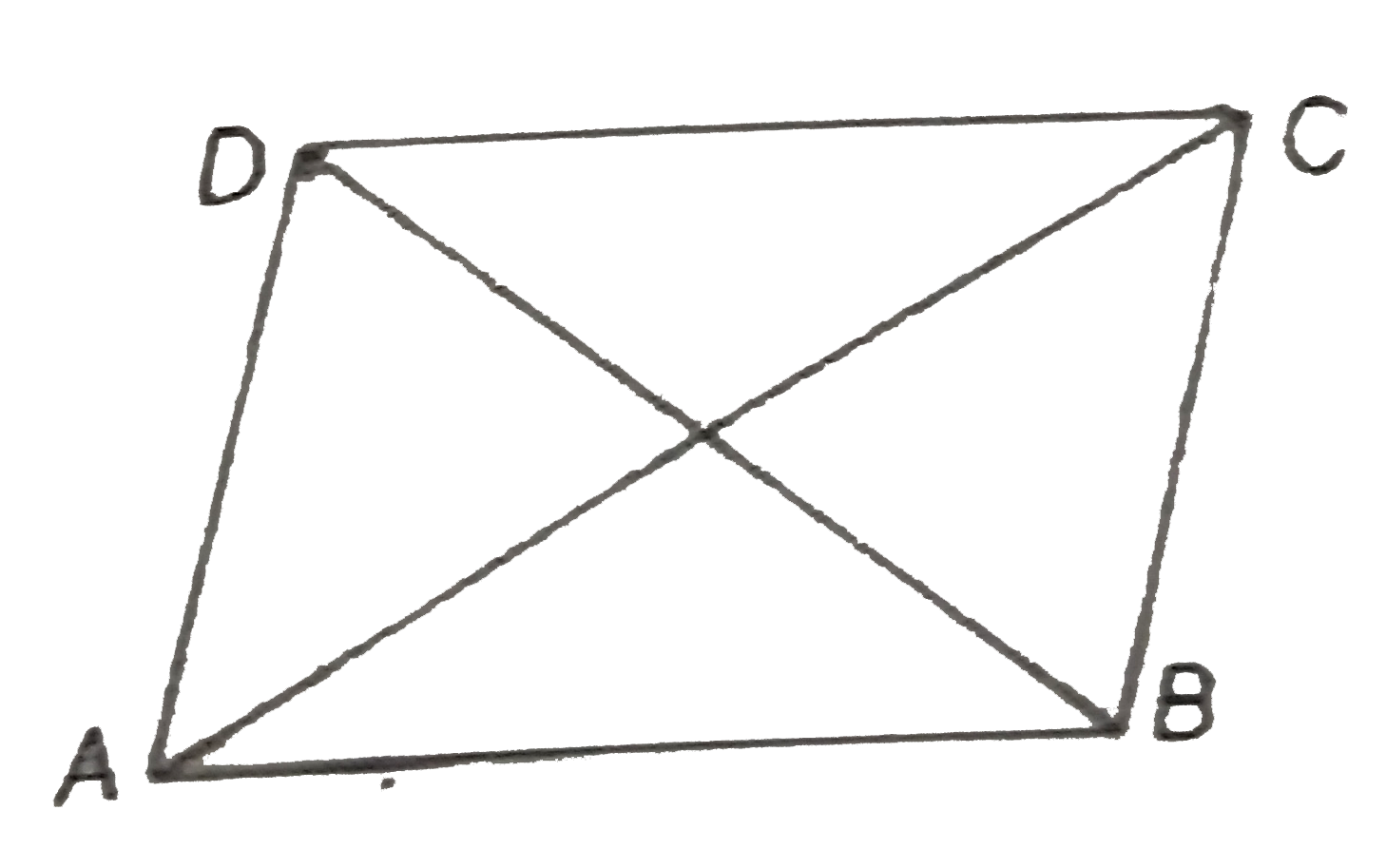Let →AB=3ˆi+ˆj−ˆkand→AC=ˆi−ˆj+3ˆk and a point P on the line segment BC is equidistant from AB and AC, then −−→AP is
2ˆi−ˆk
ˆi−2ˆk
2ˆi+ˆk
none of these
The correct Answer is:C
To solve the problem, we need to find the vector →AP given that point P is equidistant from the lines AB and AC. We will use the concept of angle bisectors in vectors.
1. Define the Vectors:
Given:
→AB=3^i+^j−^k
→AC=^i−^j+3^k
2. Find the Magnitudes:
Calculate the magnitudes of →AB and →AC:
|→AB|=√(32+12+(−1)2)=√9+1+1=√11
|→AC|=√(12+(−1)2+32)=√1+1+9=√11
3. Find the Direction Ratios:
The direction ratios of →AB and →AC are:
→AB=(3,1,−1),→AC=(1,−1,3)
4. Find the Angle Bisector:
The vector →AP (the angle bisector) can be found using the formula:
→AP=→AB|→AB|+→AC|→AC|
Since |→AB|=|→AC|=√11:
→AP=1√11(3^i+^j−^k)+1√11(^i−^j+3^k)
5. Combine the Vectors:
Combine the components:
→AP=1√11((3+1)^i+(1−1)^j+(−1+3)^k)
Simplifying this gives:
→AP=1√11(4^i+0^j+2^k)=4√11^i+2√11^k
6. Final Result:
The vector →AP is:
→AP=4√11^i+2√11^k
Given:
→AB=3^i+^j−^k
→AC=^i−^j+3^k
Calculate the magnitudes of →AB and →AC:
|→AB|=√(32+12+(−1)2)=√9+1+1=√11
|→AC|=√(12+(−1)2+32)=√1+1+9=√11
The direction ratios of →AB and →AC are:
→AB=(3,1,−1),→AC=(1,−1,3)
The vector →AP (the angle bisector) can be found using the formula:
→AP=→AB|→AB|+→AC|→AC|
Since |→AB|=|→AC|=√11:
→AP=1√11(3^i+^j−^k)+1√11(^i−^j+3^k)
Combine the components:
→AP=1√11((3+1)^i+(1−1)^j+(−1+3)^k)
Simplifying this gives:
→AP=1√11(4^i+0^j+2^k)=4√11^i+2√11^k
The vector →AP is:
→AP=4√11^i+2√11^k
Topper's Solved these Questions
- BOOK - OBJECTIVE RD SHARMA ENGLISHCHAPTER - ALGEBRA OF VECTORSEXERCISE - Exercise30videos
ALGEBRA OF VECTORS
- BOOK - OBJECTIVE RD SHARMA ENGLISHCHAPTER - ALGEBRA OF VECTORSEXERCISE - Chapter Test30videos
ALGEBRA OF VECTORS
- BOOK - OBJECTIVE RD SHARMA ENGLISHCHAPTER - ALGEBRAIC INEQUATIONSEXERCISE - Exercise39videos
ALGEBRAIC INEQUATIONS
Similar Questions
In a ΔABC, if −−→AB=ˆi−7ˆj+ˆkand−−→BC=3ˆj+ˆj+2ˆk, then ∣∣∣−−→CA∣∣∣=
View SolutionIf →a=ˆi+3ˆj,→b=2ˆi−ˆj−ˆkand→c=mˆi+7ˆj+3ˆk are coplanar then find the value of m.
View SolutionIf vector →a=ˆi+ˆj+ˆk,→b=4ˆi+3ˆj+4ˆk and →c=ˆi+αˆj+βˆk are linearly dependent and |→c|=√3 , then value of |α|+|β| is
View SolutionIf a=3ˆi−2ˆj+ˆk,b=2ˆi−4ˆj−3ˆkandc=−ˆi+2ˆj+2ˆk, then a+b+c is
View SolutionLet →a=ˆi−ˆj+ˆk,→b=2ˆi+ˆj+ˆkand→c=ˆi+ˆj−2ˆk, then the value of [→a→b→c] is equal to
View SolutionLet −−→OA=ˆi+3ˆj−2ˆkand−−→OB=3ˆi+ˆj−2ˆk. Then vector −−→OC biecting the angle AOBandC being a point on the line AB is
View SolutionIf the point of intersection of the line
→r=(ˆi+2ˆj+3ˆk)+λ(2ˆi+ˆj+2ˆk) and the plane →r(2ˆi−6ˆj+3ˆk)+5=0 lies on the plane →r(ˆi+75ˆj+60ˆk)−α=0, then 19α+17 is equal to :View SolutionIf →r.(2ˆi+3ˆj−2ˆk)+32=0 is the equation of a plane and ˆi−2ˆj+3ˆk is a point then a point equidistasnt from the plane on the opposite side is
(A) ˆi+2ˆj+3ˆk (B) 3ˆi+ˆj+ˆk (C) 3ˆi+2ˆj+3ˆk (D) 3(ˆi+ˆj+ˆk)View SolutionGiven: →p=−ˆi−3ˆj+2ˆk and →r=ˆi+3ˆj+5ˆk. Find vector parallel to electric field at position r. [ Note that →p.→r=0]
View SolutionIf in the shown figure AC=ˆi+2ˆj+4ˆk and BD=ˆi−3ˆj+ˆk then BC is
 View Solution
View Solution

